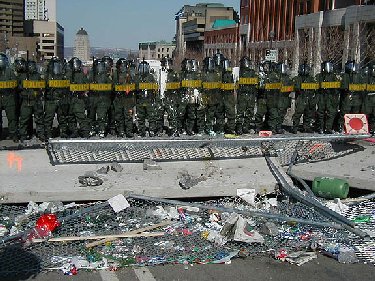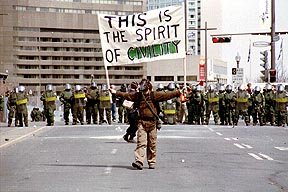
 |
After the major demonstrations against the Free Trade Area of the Americas (FTAA) in Quebec last week, many newspapers reported that protesters tried 'unsuccessfully' to tear down a chain-link security fence surrounding the summit site. I can testify that anyone outside the perimeter knew that the fence was down in numerous places, and that the first 'penetration of the perimeter' took place Friday in the afternoon, and was shown on television that night. Quebec was very different from Seattle. By erecting the fence, the authorities admitted defeat from the start. This was an elitist event, and the public was told STAY OUT! In Seattle, non-violent protesters committed civil disobedience by sitting in at intersections: they were teargassed, beaten, and arrested. In Quebec, there were no intersections to occupy; there was only a fence. Non-violent protesters, black bloc anarchists and the outraged residents of Quebec had one goal in mind: tear down the fence. No one quibbled about destruction of property: who did that fence belong to, anyway? It was ersatz. And everyone gaily proceeded to bring it down.
For me, it was a thrilling day of protest. I saw creative non-violent resistance in action.
Midday on Saturday, at the end of a short alley off Rue St. Jean, the security fence had been torn down. The police were positioned in front of it cheek to jowl, shield next to shield, facing off the protesters about five yards away. With members of the Women's International League for Peace and Freedom (WILPF) I had left the legal march on the lower level of Quebec City and walked up a car-less road to the upper old city. We didn't have a map, and weren't sure where to find the action. But we soon ran into the Reclaiming Collective, women who trained and bonded with Starhawk, the well known eco-feminist activist who led five days of training in Burlington weeks before the FTAA actions.
 |
I recognized them from a distance by their distinctive dragonflies on poles, made out of plastic bottles glued together to form large insects. Iridescent in the light, they symbolized the Collective's spirit of transcending the perimeter by flying over and ignoring it. They also had two banners to follow through the crowds; a blue one for those willing to risk arrest, and a red one for those doing support.
Vermonters Ruby Perry, Raven Davis, and Evergreen milled around with several dozen women and men, trying to figure out their next move. They were well organized, with maps and scouts, reconnoitering the energy and tension of the streets.
Walking up to Rue St Jean, we made our way thro/Grethe crowd toward the fenced area, drumming and chanting, "Hold on, hold on, to the vision, until it is born," or in French, "Gardez le vision...". This was the third day of street actions, so people recognized them. They called themselves the living river. Ruby said afterwards, "Over those several days, we flowed into the center of whatever was going on, like a river bringing fresh water and energy to a confrontation or a standoff. With the beat of our drums we matched the rhythm of the group that we joined."
A scout reported that a situation of unusual tension lay ahead. The blue flag contingent turned into the alley, making its way to the front of the protesters confronting the serried line of police. Soon Starhawk and several Reclaiming women were standing in the middle of the front row. I followed them, hugging the wall, figuring it would be a better place to be when the tear gas came. I'd be less likely to get crushed as people stumbled and rushed out of the alley. (Courage is a half-baked thing, in most of us!).
I carried a still camera, but wished I had brought my video camera to capture the powerful sounds and movement: chants, humming, call and response, pleas for calm and non-violence all reverberating within this small restricted space; walls on two sides, two groups of people confronting each other with a small area of neutral space between them. It was an intense theater event: performance art, perhaps, or a ritual. But who was the audience and who the performers? Or were we all participants?
Someone said, "Lets move forward," and the group moved forward one step. There was a pause, and the police responded, "Move back or we'll use tear gas!," their police sticks at the ready, in front of their shields. Then a woman cried out, "Sit down!" and, as one body, the whole group of 60 or so responded. In a sitting position we were more vulnerable, but more resistant, like rocks. Starhawk and the woman next to her handed their drums back to the people behind so that the drums would be protected in case of violence. Then someone from Reclaiming began to read, first in English and then in French, from the Cochabamba Declaration, written by Bolivians after retaking their water supply from Bechtel's privatization plan: "All People have the right to water... Water belongs to the earth and all species and is sacred to life..."
For about 20 minutes we sat there, facing a force that could injure us at any moment, bringing the needs, requests and dreams of the people of our earth to this spontaneous public forum on the perimeter of corporate and state power. It wasn't "merely symbolic." The possibility of violence and injury were palpable. Were the police able to hear us through their DarthVader costumes? The goal wasn't to convert the police, but rather to confirm, justify and celebrate our resistance. Our action replicated innumerable encounters in the resisting world, of citizens speaking truth to power – the Zapatistas, day in and day out, confronting the Mexican Army; Bolivians demanding the return of their water supply from privatization; the people of India protesting the construction of the World Bank funded Narmada Dam. An invocation rose up to tear down the walls of privilege and wealth, demanding justice and true democracy.
The women of the Reclaiming Collective define magic as the art of changing consciousness at will. I felt magic happened on many fronts during that Saturday afternoon amidst the tumbling of the walls. (Informal estimates are that 150 meters of fence was torn down).